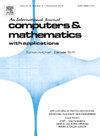Primal-mixed finite element methods for the coupled Biot and Poisson–Nernst–Planck equations
IF 2.9
2区 数学
Q1 MATHEMATICS, APPLIED
引用次数: 0
Abstract
We propose mixed finite element methods for the coupled Biot poroelasticity and Poisson–Nernst–Planck equations (modeling ion transport in deformable porous media). For the poroelasticity, we consider a primal-mixed, four-field formulation in terms of the solid displacement, the fluid pressure, the Darcy flux, and the total pressure. In turn, the Poisson–Nernst–Planck equations are formulated in terms of the electrostatic potential, the electric field, the ionized particle concentrations, their gradients, and the total ionic fluxes. The weak formulation, posed in Banach spaces, exhibits the structure of a perturbed block-diagonal operator consisting of perturbed and generalized saddle-point problems for the Biot equations, a generalized saddle-point system for the Poisson equations, and a perturbed twofold saddle-point problem for the Nernst–Planck equations. One of the main novelties here is the well-posedness analysis, hinging on the Banach fixed-point theorem along with small data assumptions, the Babuška–Brezzi theory in Banach spaces, and a slight variant of recent abstract results for perturbed saddle-point problems, again in Banach spaces. The associated Galerkin scheme is addressed similarly, employing the Banach fixed-point theorem to yield discrete well-posedness. A priori error estimates are derived, and simple numerical examples validate the theoretical error bounds, and illustrate the performance of the proposed schemes.
求助全文
约1分钟内获得全文
求助全文
来源期刊

Computers & Mathematics with Applications
工程技术-计算机:跨学科应用
CiteScore
5.10
自引率
10.30%
发文量
396
审稿时长
9.9 weeks
期刊介绍:
Computers & Mathematics with Applications provides a medium of exchange for those engaged in fields contributing to building successful simulations for science and engineering using Partial Differential Equations (PDEs).
 求助内容:
求助内容: 应助结果提醒方式:
应助结果提醒方式:


